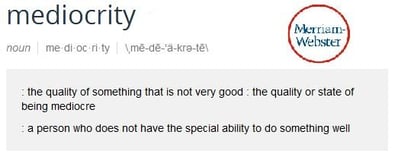Checklist: Is Your Remodeling Business at Risk of Becoming Mediocre?
 As you grow your business day to day management and leadership considerations can quickly creep up on construction business owners. Profitably growing a remodeling business to any volume, but in particular growing past the $1M threshold in produced work, definitely requires advanced business skills. Growing and running your business by the seat of your pants is a sure way to create a mediocre business that will never generate maximum profits. This article offers several ways business owners can determine if they and their businesses are headed for mediocrity. It also offers options to help you and your business get back on track.
As you grow your business day to day management and leadership considerations can quickly creep up on construction business owners. Profitably growing a remodeling business to any volume, but in particular growing past the $1M threshold in produced work, definitely requires advanced business skills. Growing and running your business by the seat of your pants is a sure way to create a mediocre business that will never generate maximum profits. This article offers several ways business owners can determine if they and their businesses are headed for mediocrity. It also offers options to help you and your business get back on track.
Here is a checklist of indicators that your business is becoming mediocre:
- Your business lacks written policies and procedures.
- Even if you have policies you do not have predetermined consequences for violating them and or you do not enforce them.
- You complain about things customers and or employees do or don't do; but then do nothing about them.
- Concerned employees point certain concerning things out and you do nothing to address and or correct things.
- Your employees point things out to you and you actually make them feel guilty for doing so or that they are annoying you by pointing them out.
- Your customers offer feedback or complaints and you make excuses for why things happened, rather than embrace their help and use what they share with you to make improvements or corrections.
- Long term customers stop doing business with you and you don’t bother to ask them why.
- You create artificial harmony by ignoring culture deficiencies and or tension between team members and pretend everything is OK.
- When something happens you always find a way to make it someone else's fault rather than take responsibility as the leader.
If these things are happening at your business you have two options
 The first is to let them keep happening. If you allow things to continue you will likely lose customers, compromise your brand, have high employee turnover and you will never fully achieve creating a successful and profitable business. Eventually, when your family and others ask you why you never really succeeded in business, you will again have to resort to rationalizing why it was someone else's fault.
The first is to let them keep happening. If you allow things to continue you will likely lose customers, compromise your brand, have high employee turnover and you will never fully achieve creating a successful and profitable business. Eventually, when your family and others ask you why you never really succeeded in business, you will again have to resort to rationalizing why it was someone else's fault.
Your other option is to recognize these things are happening and start addressing why they are happening. Only until you know and recognize why they are happening will you be able to work on preventing them from happening.
Preventing these things from happening may require two different solutions
The first is to stop certain things from happening all together by no longer tolerating them. Put your big boy or girl pants on and be the leader you should be. To hold others accountable make sure you create and follow through on consequences.
The other is to change how you do things so they just don't happen anymore. Put policies in place and make sure they are enforced. Those policies should also include clear consequences for violating them.
Lots of remodeling businesses are becoming mediocre as they try to grow in this improving economy. Will you join them or will you stand out from the crowd by becoming the reference standard for what it means to be a professional contractor in your marketplace?



 Since selling my remodeling business in 2004, many remodelers have asked me for help and insight about how I did it and how they too could sell their businesses some day. They ask great questions. The challenge is that there is no easy one size fits all answer. In this article I will share a few big picture considerations to help guide you. In a follow up article I will discuss typical buyer types you can consider as possible prospects to sell to.
Since selling my remodeling business in 2004, many remodelers have asked me for help and insight about how I did it and how they too could sell their businesses some day. They ask great questions. The challenge is that there is no easy one size fits all answer. In this article I will share a few big picture considerations to help guide you. In a follow up article I will discuss typical buyer types you can consider as possible prospects to sell to.
 If you’re considering selling your business some day you will need to consider the types of buyers out there as well as their typical motivations for buying one business versus another. In my next blog I will discuss the two typical buyer types you will want to consider as you make you plan and write your for sale ad.
If you’re considering selling your business some day you will need to consider the types of buyers out there as well as their typical motivations for buying one business versus another. In my next blog I will discuss the two typical buyer types you will want to consider as you make you plan and write your for sale ad. Newton’s Law of Momentum states that “A body in motion tends to stay in motion and tends to continue in the same direction.” Remodelers who downsized their businesses during the recession might want to consider Newton’s law.
Newton’s Law of Momentum states that “A body in motion tends to stay in motion and tends to continue in the same direction.” Remodelers who downsized their businesses during the recession might want to consider Newton’s law.  If you have convinced yourself that your business isn’t really all that bad when you compare it to other dysfunctional businesses that are worse off than yours, yours will never achieve true success. Being less bad is not good. Rather than judge your business on relative success, you should judge it based on absolute success. Again this requires planning, but also requires establishing metrics against which you, and anyone else who reads your plan, can measure whether your plan is working and is actually leading you towards predefined success. Keep in mind that being better off than you used to be might not be a great place to be either. Think of it this way;
If you have convinced yourself that your business isn’t really all that bad when you compare it to other dysfunctional businesses that are worse off than yours, yours will never achieve true success. Being less bad is not good. Rather than judge your business on relative success, you should judge it based on absolute success. Again this requires planning, but also requires establishing metrics against which you, and anyone else who reads your plan, can measure whether your plan is working and is actually leading you towards predefined success. Keep in mind that being better off than you used to be might not be a great place to be either. Think of it this way; There are many remodeling business myths that seem to have become truths for way too many remodelers. That’s too bad. Believing those myths may be holding them back from being able to grow their businesses. Allowing these myths to remain in place will definitely prevent remodelers from successfully growing their businesses past the $1 Million installed sales threshold.
There are many remodeling business myths that seem to have become truths for way too many remodelers. That’s too bad. Believing those myths may be holding them back from being able to grow their businesses. Allowing these myths to remain in place will definitely prevent remodelers from successfully growing their businesses past the $1 Million installed sales threshold. Again, will you jump off the bridge, too? Will Delta Airlines let you pay after you land? Completing remodeling services without being paid for them before you do them is in my opinion foolish, and a huge risk for most remodelers. It instantly creates cash flow challenges in a business where cash is king. Breaking $1M without good cash flow might be the death of your business. Here is how you can create payment schedules that keep you ahead of your customer:
Again, will you jump off the bridge, too? Will Delta Airlines let you pay after you land? Completing remodeling services without being paid for them before you do them is in my opinion foolish, and a huge risk for most remodelers. It instantly creates cash flow challenges in a business where cash is king. Breaking $1M without good cash flow might be the death of your business. Here is how you can create payment schedules that keep you ahead of your customer: 
 Owners should seek to put a more refined structure in place for the purpose of better, faster, and more accurate information. This is a critical step towards the owner’s ability to evolve away from the micromanagement of employees.
Owners should seek to put a more refined structure in place for the purpose of better, faster, and more accurate information. This is a critical step towards the owner’s ability to evolve away from the micromanagement of employees. Give salespeople the support they need to support sales less on their own, sell more and keep them selling profitably.
Give salespeople the support they need to support sales less on their own, sell more and keep them selling profitably.
 This stage of business growth is what I refer to as the “Take-Off Stage” for a remodeling business because either the business takes off successfully, or it doesn’t. Another way of looking at it might be either the business owner commits to doing it and doing it right, or accepts the status quo of accidental and unplanned growth.
This stage of business growth is what I refer to as the “Take-Off Stage” for a remodeling business because either the business takes off successfully, or it doesn’t. Another way of looking at it might be either the business owner commits to doing it and doing it right, or accepts the status quo of accidental and unplanned growth. Through experience an advanced
Through experience an advanced 
 You can invest now to train managers or employees and to rework structural shortcomings within your business. Or you can pay forever by running a shoddy show that won't give you the financial returns that it takes to stay in business and retire before your body eventually gives out.
You can invest now to train managers or employees and to rework structural shortcomings within your business. Or you can pay forever by running a shoddy show that won't give you the financial returns that it takes to stay in business and retire before your body eventually gives out. 
 Many contractors hire for today. By that I mean they hire the help they think they need for the projects they have on the books and the current size of the business. If you plan to grow your business these employees may not have the skills or desire to grow with the business. If you think about how much you want to grow, the organizational charts you will need at different stages of growth, and the job descriptions for each position on the organizational charts, you can make better hiring decisions. And, long term, you will have less employee turnover and therefore lower training related expenses over time as well.
Many contractors hire for today. By that I mean they hire the help they think they need for the projects they have on the books and the current size of the business. If you plan to grow your business these employees may not have the skills or desire to grow with the business. If you think about how much you want to grow, the organizational charts you will need at different stages of growth, and the job descriptions for each position on the organizational charts, you can make better hiring decisions. And, long term, you will have less employee turnover and therefore lower training related expenses over time as well. Being the” Jack of All Trades” to everyone who calls your business may work for a self employed handyman or carpenter, but that’s not a good strategy if you want to be a construction business owner with a growing business. Deciding your niches can help you streamline and personalize your business systems so they serve both your business as well as your customers in a consistent and reliable way. For example becoming a Design/Builder may limit who will do business with you, but on the other hand making a commitment to that business delivery method you can develop a marketing and sales process that generates the qualified leads and sales you need and will help your business become known as a Design/Build expert in your desired target market area. My own experience made it obvious to me that consumers are willing to pay more for experts than they typically will pay for a “Jack of all Trades”.
Being the” Jack of All Trades” to everyone who calls your business may work for a self employed handyman or carpenter, but that’s not a good strategy if you want to be a construction business owner with a growing business. Deciding your niches can help you streamline and personalize your business systems so they serve both your business as well as your customers in a consistent and reliable way. For example becoming a Design/Builder may limit who will do business with you, but on the other hand making a commitment to that business delivery method you can develop a marketing and sales process that generates the qualified leads and sales you need and will help your business become known as a Design/Build expert in your desired target market area. My own experience made it obvious to me that consumers are willing to pay more for experts than they typically will pay for a “Jack of all Trades”. Successfully growing a residential construction business is not easy and takes time. If you go it alone you will likely attend many sessions at the “Lumberyard School of Hard Knocks”. That educational institution can be expensive, frustrating and may require you scrap a lot of what you have done in your business because it will no longer work well enough as you grow the business. With the right professional help and guidance you can reduce the overall long term cost of your path to success and you can get there much faster. Considering the principle of compounded interest, the more profit dollars you earn and keep each year along your path, the bigger your nest egg can be when you are finally ready to exit your business.
Successfully growing a residential construction business is not easy and takes time. If you go it alone you will likely attend many sessions at the “Lumberyard School of Hard Knocks”. That educational institution can be expensive, frustrating and may require you scrap a lot of what you have done in your business because it will no longer work well enough as you grow the business. With the right professional help and guidance you can reduce the overall long term cost of your path to success and you can get there much faster. Considering the principle of compounded interest, the more profit dollars you earn and keep each year along your path, the bigger your nest egg can be when you are finally ready to exit your business. 
 The same is actually true for most Americans. According to
The same is actually true for most Americans. According to  Most construction business owners I speak with haven’t done any retirement planning. In fact 56% of American workers haven’t bothered to figure how much they’ll need to retire comfortably either. (Source: Employee Benefit Research Institute) How then could these contractors even know how much money they will need to retire and when they can actually retire? For these contractors I am pretty confident they won’t have what they need.
Most construction business owners I speak with haven’t done any retirement planning. In fact 56% of American workers haven’t bothered to figure how much they’ll need to retire comfortably either. (Source: Employee Benefit Research Institute) How then could these contractors even know how much money they will need to retire and when they can actually retire? For these contractors I am pretty confident they won’t have what they need. If earning a wage isn’t earning you enough to retire on, you might want to learn how to become a real business owner.
If earning a wage isn’t earning you enough to retire on, you might want to learn how to become a real business owner.
 Not knowing the true costs of being in business as your business grows and being surprised about the costs when the bills come in.
Not knowing the true costs of being in business as your business grows and being surprised about the costs when the bills come in.







